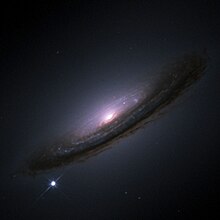
In astronomy, a Hubble bubble would be "a departure of the local value of the Hubble constant from its globally averaged value,"[1] or, more technically, "a local monopole in the peculiar velocity field, perhaps caused by a local void in the mass density."[2]
The Hubble constant, named for astronomer Edwin Hubble, whose work made clear the expansion of the universe, measures the rate at which expansion occurs. In accordance with the Copernican principle that the Earth is not in a central, specially favored position, one would expect that measuring this constant at any point in the universe would yield the same value. If, on the other hand, Earth were at or near the center of a very low-density region of interstellar space (a relative void), the local expansion would be faster due to the lack of nearby mass to slow it down. Thus, stars inside such a "Hubble bubble" would accelerate away from Earth faster than the general expansion of the universe.[1][3] This situation could provide an alternative to dark energy in explaining the apparent accelerating universe[3] or contribute to explanations of the Hubble tension.[4][5]
- ^ a b "Hubble Bubble". The Astronomist. 29 July 2010. Retrieved 2 February 2011.
- ^ Conley, A; RG Carlberg; J Guy; DA Howell; S Jha; A Riess; M Sullivan (2007). "Is there evidence for a Hubble Bubble? The nature of Type Ia supernova colors and dust in external galaxies". Astrophysical Journal. 664 (1): L13–L16. arXiv:0705.0367. Bibcode:2007ApJ...664L..13C. doi:10.1086/520625. S2CID 11074723.
- ^ a b Cite error: The named reference
mosswas invoked but never defined (see the help page). - ^ Kenworthy, W. D'Arcy; Scolnic, Dan; Riess, Adam (2019-04-24). "The Local Perspective on the Hubble Tension: Local Structure Does Not Impact Measurement of the Hubble Constant". The Astrophysical Journal. 875 (2): 145. arXiv:1901.08681. Bibcode:2019ApJ...875..145K. doi:10.3847/1538-4357/ab0ebf. ISSN 1538-4357. S2CID 119095484.
- ^ Freedman, Wendy L. (2021-09-17). "Measurements of the Hubble Constant: Tensions in Perspective*". The Astrophysical Journal. 919 (1): 16. arXiv:2106.15656. Bibcode:2021ApJ...919...16F. doi:10.3847/1538-4357/ac0e95. ISSN 0004-637X. S2CID 235683396.